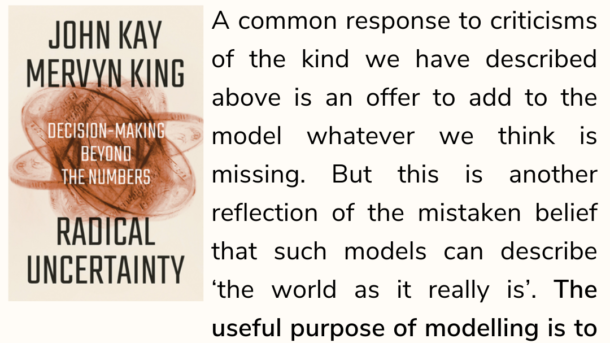We draw a number of lessons for the use of models in business and government. First, deploy simple models to identify the key factors that influence an assessment. A common response to criticisms of the kind we have described above is an offer to add to the model whatever we think is missing. But this is another reflection of the mistaken belief that such models can describe ‘the world as it really is’. The useful purpose of modelling is to find ‘small world’ problems which illuminate part of the large world of radical uncertainty. Second, having identified the parameters which are likely to make a significant difference to an assessment, undertake research to obtain evidence on the value of these parameters. For example, what value do rail passengers attach to a faster journey? Quantification can often serve as a reality check even when precise quantification is obviously spurious. The preservation of the beautiful and well-preserved Norman church at Stewkley in England (close to a proposed new high-speed rail line) is worth something, but surely not a billion pounds. Often this kind of calibration is enough to resolve some aspects of a decision. Third, simple models provide a flexibility which makes it much easier to explore the effects of modifications and alternatives. For example, the WHO demographic model not only diverted attention from the key issue but its complexity made it harder to investigate alternative specifications of the model structure and parameters. Scenarios are always useful in conditions of radical uncertainty. How might this policy decision look in five years’ time – or fifty? Fourth, under radical uncertainty, the options conferred by a policy may be crucial to its evaluation. Faced with a choice as to which of London’s two major airports, Gatwick or Heathrow, should be chosen for expansion, recognition that the topography of Gatwick allows piecemeal adaptation of the development of facilities in the light of uncertain future demand, while that of Heathrow does not, should be an important factor in the choice. Options may be positive or negative in value – facilitating policies not directly connected to the initial objectives, or excluding possible attractive alternatives. In the end, a model is useful only if the person using it understands that it does not represent ‘the world as it really is’, but is a tool for exploring ways in which a decision might or might not go wrong.
Are models useful in a world of radical uncertainty?
Certainly, but not in the way we are normally accustomed to. In this excerpt, what the authors suggest is to view models as a way to replicate ‘small world’ problems that serve as part of a larger problem. While no model can be an accurate representation of the world, we can use simple models to illuminate the choices we can make for smaller decisions.
The example given was simply finding a way to quantity the value rail passengers attach to a faster journey. While models alone would not help you determine what is needed for an effective railway system, having a good understanding of how much passengers value speed goes a long way in illuminating the right decisions.
In such cases, simplicity prevails.
In a complex and uncertain world, a simpler model allows you to have the flexibility in changing the parameters whenever you see fit. We might generally think that adding more details lead to a more “accurate representation”. However, the author contends that that is seldom the case and what happens is you end up diverting attention away from the key issue.
If we accept that we live in an uncertain world that cannot be predicted, then the best course of action is to remain adaptable. Select choices that provide you flexibility for change if you are uncertain of the result.



